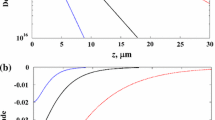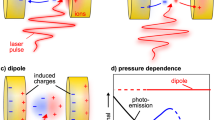Abstract
Allowing for the simultaneous determination of the photocarriers drift mobilities and their small-signal recombination lifetime, the Moving photocarrier Grating Technique (MGT) is a useful characterization tool for photoconductive semiconductors. This technique is based on measuring the steady-state direct current induced by an interference pattern (IP) moving at a constant velocity between two coplanar ohmic contacts deposited on the semiconductor. The main drawback of the technique is the low level of the signal to be measured, which can be masked by noise. The Oscillating Photocarrier Grating technique (OPG), where the IP oscillates at a constant speed, has been proposed as an alternating current version of MGT, providing a higher signal-to-noise ratio. The IP oscillation is produced by the phase modulation of one of the interfering beams. Using the multiple trap** model we deduce the expression of the current density generated by OPG in a photoconductor. We observed theoretically and experimentally that OPG is not equivalent to MGT for the previously used amplitude of oscillation, especially when the IP moves at high speeds. However, we show that the desired equivalence between both techniques could be recovered by increasing the amplitude of oscillation. A phase modulator capable of achieving such amplitudes is required for the correct implementation of OPG.









Similar content being viewed by others
Notes
The dielectric relaxation time is given by the ratio of the material permittivity and the steady-state conductivity.
References
F. Ventosinos, N. Budini, C. Longeaud, J.A. Schmidt, J. Phys. D. Appl. Phys. 44, 295103 (2011)
S. Stepanov, Handb. Adv. Electron. Photonic Mater. Devices. (Academic Press, San Diego, 2001), pp. 205–276
U. Haken, M. Hundhausen, L. Ley, J. Non. Cryst. Solids 164–166, 497 (1993)
C. Witt, U. Haken, M. Hundhausen, Jpn. J. Appl. Phys. 33, L1386 (1994)
F. Ventosinos, C. Longeaud, J.A. Schmidt, J. Non. Cryst. Solids 358, 2031 (2012)
C. Longeaud, F. Ventosinos, J.A. Schmidt, J. Appl. Phys. 112, 023709 (2012)
L. Kopprio, F. Ventosinos, J. Schmidt, Rev. Sci. Instrum. 90, 123902 (2019)
R.A. Street, Hydrogenated Amorphous Silicon (Cambridge University Press, Cambridge, 1991).
A. Merazga, S. Tobbeche, C. Main, A. Al-Shahrani, S. Reynolds, J. Phys. Condens. Matter 18, 3721 (2006)
C. Longeaud, S. Tobbeche, J. Phys. Condens. Matter 21, 045508 (2009)
K. Hattori, Y. Koji, S. Fukuda, W. Ma, H. Okamoto, Y. Hamakawa, J. Appl. Phys. 73, 3846 (1993)
D. Ritter, K. Weiser, E. Zeldov, J. Appl. Phys. 62, 4563 (1987)
M. Haridim, K. Weiser, H. Mell, Philos. Mag. B Phys. Condens. Matter Stat. Mech. Electron. Opt. Magn. Prop. 67, 171 (1993)
R. Paschotta, article on 'Beam Radius' in the RP Photonics Encyclopedia, <https://www.rp-photonics.com/beam_radius.html>. Accessed on 06 September 2020.
https://www.jenoptik.com/products/optoelectronic-systems/lightmodulation/integrated-optical-modulators-fiber-coupled/phase-modulator. Accessed on 26 September 2019.
Acknowledgements
We acknowledge support from the Argentine National Scientific and Technical Research Council under Project Nos. PUE 22920160100054CO and PIP 0414; Argentine National Agency for Science and Technology Promotion under Project No. PICT-2016-1389; National University of the Littoral under project CAI+D 50420150100108LI.
Author information
Authors and Affiliations
Corresponding author
Additional information
Publisher's Note
Springer Nature remains neutral with regard to jurisdictional claims in published maps and institutional affiliations.
Appendices
Appendix A
Deduction of the current density expression at the fundamental frequency
It is convenient to write the oscillation amplitude of the phase as App = lπ, being l a positive number. It can be shown that when App is a multiple of π (integer l), of the infinite terms that make up the generation rate (Eq. 7) no more than 6 influence the current induced at the fundamental frequency. These terms are given by:
Note that for l = 1 there are only five terms since in Eq. 19 we have a single term g0. When l is integer, the obtained complex amplitude of the average current density at the fundamental frequency is:
where the asterisk as superscript corresponds to the complex conjugation of the number. When \({\xi}_{ext}=0\), the symmetry between the generation rates \({g}_{\Omega}={g}_{-\Omega}\) implies the following relationships for the conductivity and the electric field amplitudes:
In this case, Eq. 22 simplifies to:
Note that under these circumstances, we only need to solve the general equations for three traveling waves with different values of Ω to obtain the current density induced at the fundamental frequency.
When App is not a multiple of π (l is not an integer), the expression for the amplitude of the average current density induced at the fundamental frequency has infinite terms and is given by
For App = 3π/4, π/2 and π/4, the harmonic terms’ amplitudes of the generation rate are, respectively, given by:
where i = 0, 1, 2, ⋯. In these cases, is also verified that gΩ = g-Ω; therefore, in the absence of an external electric field (ξext = 0), Eq. 23 are also verified. With these simplifications Eq. 25 reduces to:
Appendix B
Equivalence between MGT and OPG for A pp multiple of \({\varvec{\pi}}\)
In this appendix, we prove, for App multiple of π, that Eq. 6 is strictly verified in the linear region of small frequencies. In the high-frequency regime we show that, the better the inequality App ≫ π is fulfilled, the better Eq. 6 is satisfied.
In appendix A of Ref. [7] are solved the general transport equations for a generation rate consisting of an arbitrary harmonic travelling wave on a much greater uniform background. The harmonic amplitudes of the photoconductivity and electric field can be rewritten in the following way:
where \(\Delta \sigma_{\Omega }^{0}\) and \(\Delta \xi_{\Omega }^{0}\) do not depends on the harmonic amplitude of the generation rate, gΩ. The first-order Taylor expansion of \(\Delta \sigma_{\Omega }^{0}\) and \(\Delta \xi_{\Omega }^{0}\) at Ω = 0 are:
where \(\Delta \sigma_{0}^{0}\) and \(\left( {\Delta \xi_{0}^{0} } \right)^{\prime }\) are real numbers, while \(\left( {\Delta \sigma_{0}^{0} } \right)^{\prime }\) and \(\Delta \xi_{0}^{0}\) are imaginary. Replacing Eqs. 30 in the expression of the MGT current density [7], it is obtained:
Substituting Eqs. 31 in Eq. 32, discarding the higher-order terms and after some algebra, we get the expression of MGT current density in the low-frequency region:
Replacing Eq. 30 in Eq. 24 and using Eqs. 19–21, we obtain the following formula for the current density induced by OPG at the fundamental frequency when App is a multiple of π:
Substituting Eqs. 31 in 34, dismissing the higher-order terms and after some algebra we get the equation for OPG current density in the low-frequency region:
Taking the modulus of Eqs. 33 and 35, and using the relationship \(\left| {\Delta \omega } \right| = l\omega_{0}\), we obtain Eq. 6.
The inequality App ≫ π is equivalent to l ≫ 1. Discarding the \(1\) in front of \(l\) and \(2l\) in Eq. 34, we get the formula of OPG current density in this case:
Taking the modulus of Eqs. 32 and 36 and assuming \(\left| {\Delta \omega } \right| = l\omega_{0}\), we get Eq. 6. Note that the inequality App ≫ π or l ≫ 1, is also equivalent to a maximum displacement of the interference pattern much greater than half its spatial period (Dpp ≫ \(\Lambda\)/2).
Appendix C
Electro-optic modulator (EOM)
In a typical linear EOM, the refractive indexes in the main directions of the active crystal (perpendicular to each other) are directly proportional to the applied voltage. The proportionality constant is the same in both directions, although of opposite signs. In the absence of voltage applied to the modulator, a linearly polarized beam of light retains its initial polarization because the refractive indices are equal in both directions. Therefore, its electric field written in the main directions of the modulator is,
where θ is the angle that forms the electric field of the incident beam with the main direction \({\hat{\text{x}}}\) of the EOM. By applying a potential difference to the modulator, there is an increase in the optical path for polarized light in one main direction and a decrease in the optical path of the same magnitude for polarized light in the other main direction. In this case, the electric field of the light beam at the output of the modulator is,
Note that the EOM acts as a phase modulator of the light beam only when one of its main axes coincides with the direction of polarization of the incident light beam. On the other hand, the EOM acts as a polarization modulator capable of rotating 90° the initial direction of polarization only when the main axes of the modulator are at 45° from the polarization of the incoming light beam. In this case, Eq. 38 becomes,
When φ (V) = π/4, for example, we obtain a circularly polarized light at the output of the modulator, and for φ (V) = π/2 we obtain again linearly polarized light but rotated 90 degrees from the input direction of polarization.
Rights and permissions
About this article
Cite this article
Kopprio, L., Longeaud, C., Ventosinos, F. et al. Further insight into the oscillating photocarrier grating technique: influence of the oscillation amplitude. Appl. Phys. B 127, 28 (2021). https://doi.org/10.1007/s00340-020-07568-4
Received:
Accepted:
Published:
DOI: https://doi.org/10.1007/s00340-020-07568-4




